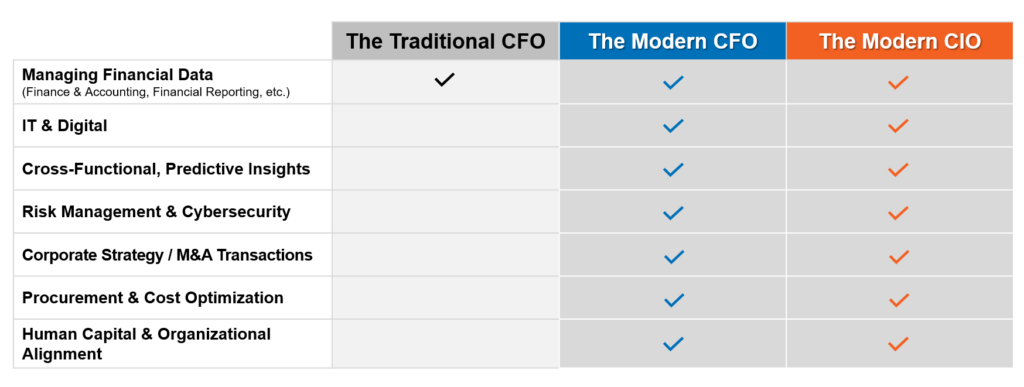As finance transformation has evolved from a one-time project to a continuous improvement culture, CFOs need additional support, alignment, and capabilities in their toolkit. Fortunately, they can look across the aisle to other key functional leaders throughout the organization, particularly the CIO, to help accelerate and capitalize on enterprise change initiatives.
Developing and perfecting this strategic partnership may feel intuitive in theory but can be challenging to implement in practice. That’s why CrossCountry Consulting’s Business Transformation Lead Keith Linhart and FloQast’s Accounting Ops Evangelist Stefan van Duyvendijk recently sat down for an in-depth discussion on making transformation work for modern CFOs and CIOs. As part of FloQademy, FloQast’s learning portal for on-demand CPE/CPD, the duo shed light on a number of critical best practices, innovative frameworks, and emerging trends in transformation.
Watch the full video here and explore key themes from the conversation below:
Transformation as the Norm
Gone are the days of one-and-done transformation. Today, CFOs are spearheading a perma-transformation environment in which employees are change-ready, digitally upskilled, and cross-functionally inclined to adopt and lead change initiatives: systems implementations, process engineering, operating model design, and more. This makes Finance a value-added business partner instead of just a traditional reporting function.

But it also means staff must be adept in a wider range of domains, like data, cybersecurity, automation, and AI, or at least augmented by additional resources that can provide these skillsets. Working cross-functionally and productively with other staff throughout the business, then, is becoming mandatory to delivering effective transformation.
“Transformation is meant to be an iterative process,” said van Duyvendijk. “It’s meant to be a feedback loop.”
In the process, teams break down departmental silos, improve knowledge-sharing, enhance collaboration, and drive strategic alignment.
An added benefit to this kind of transformation mindset is that the employees and leaders who embrace technology can drive not only organizational and competitive value but also personal opportunity. The skills gained in transformation can open up new paths to career advancement, credentialization, and social capital as further skills and rapport are acquired.
Setting the Transformation Tone Through CFO-CIO Collaboration
“Historically, finance transformation was put into place to solve a particular problem,” said Linhart. “Do you need to cut costs? Do you need to offshore? Do you need to integrate with an acquisition? Now, the driver of transformation isn’t a single problem. The driver is strategic value to the business, which is dynamic and changes every year.”
As a result, CFOs must have a more dynamic approach to transformation, especially given the evolving role of technology in Finance and Accounting. The key point of connectivity that can help drive this new kind of transformation is naturally between the Offices of the CFO and CIO.
For organizations looking to nurture this relationship, building productive communication channels and leveraging shared platforms are great places to begin. And most immediately, Finance and IT can use technology for enhanced reporting and risk management.
With tools delivering the right insights, the organization can remain ahead of the curve on many threats and opportunities.
Below are strong starting points for setting a productive CFO-CIO foundation:
- Ensure systems are in place to capture, process, and store high volumes of data efficiently, accurately, and securely.
- Focus on the key cycles that impact financial and strategic decision-making, such as close and forecasting. By reducing these cycle times, more time is available for collaborative analysis and informed decisions that benefit more than one function.
- Leverage automation and data analytics for more than just financial goals. There are also use cases for cybersecurity, audit, controls, and key risk processes.
- Align on adjacent or overlapping responsibilities, such as business continuity, disaster recovery, data protection, technology investment theses, and enterprise architecture.
- Build cultural momentum by understanding human capital concerns, forming cross-functional teams, providing clear communication and KPIs, and adopting agile delivery models.
Experimenting With Transformation’s Art of the Possible
Transformation is about thinking big by starting small.
When trying to solve for individual challenges, there are enormous implications up and downstream. That’s why even conventional financial issues, such as timely reporting, are in truth data and systems issues as well. And when digging deeper, there are people and process components at play.
This sort of root-cause analysis and holistic problem-solving is the basis for CrossCountry Consulting’s Iceberg reporting and analytics framework, which combines and visualizes financial and non-financial data for more robust quantitative and qualitative analysis. This approach surfaces comprehensive views and data-driven enterprise insights that enable companies to achieve short-term goals, like faster close, in tandem with long-term corporate objectives, like growth, M&A, and strategic pivots.
Each layer of the iceberg has a CFO and a CIO component. When analyzing where and how to best collaborate, leaders often arrive at a key question, “Is there one tool that does all this work, or are many tools needed?”
That’s why it’s critical for both functions to be aligned: neither can act decisively on this question without the other’s support. And making it to a successful future state as an organization hinges on the efficiencies and opportunities discovered in collaborative settings.
When Finance and IT work together on strategic enterprise transformation, they tap into value that previously wasn’t attainable – picking up wins along the way and charting a path toward entirely new levels of success.
Leading Transformation by Example
Modern leaders demand modern transformation frameworks that dive deeper than yesterday’s surface-level capabilities. Now, automated, integrated, real-time, and predictive insights are within reach – the very insights needed to lead a continuous transformation organization.
To systematically gather, cleanse, consolidate, report, and capitalize on complex enterprise data for your transformation journey, contact CrossCountry Consulting.